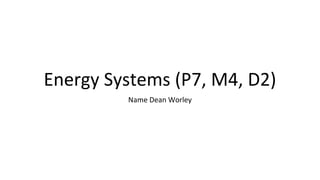
Documents energy systems (p7, m4, d2) template
- 1. Energy Systems (P7, M4, D2) Name Dean Worley
- 2. What is energy? The strength and validity required for sustained physical or mental activity, so in football this means we use energy to run jump and kick the ball. We need energy to digest food and also to repair and replace tissues in your body. Muscular contraction and movements also require energy with out energy none of this would be possible.
- 3. Where do we get energy from? Starchy and other forms of carbohydrates provide source of energy for your body to perform at its best, no matter what your sport or activity. This is where we mainly get our energy from. The more we exercise, the more carbohydrates you need to consume in order to get energy. The energy is used for- Muscular contraction and movement Circulation Transmissions of nerve impulses Digestion of foods Repairing and replacing tissues.
- 4. ATP As the name suggests the ATP-PC system consists of adenosine triphosphate (ATP) and phosphocreatine (pc). This energy system provides immediate energy through the breakdown of these stored high energy phosphates. This makes 1 molecule per creatine phosphate
- 5. ATP-PC System 1. Initially ATP stored in the myosin cross-bridges (microscopic contractile parts of muscle) is broken down to release energy for muscle contraction. This leaves the by-products of ATP breakdown: adenosine diphosphate (ADP) and one single phosphate (Pi) all on its own. 2. Phosphocreatine (PC) is then broken down by the enzyme creatine kinase into Creatine and Pi 3. The energy released in the breakdown of PC allows ADP and Pi to rejoin forming more ATP. This newly formed ATP can now be broken down to release energy to fuel activity Reference - https://www.ptdirect.com/training-design/anatomy-and- physiology/the-atp-pc-system
- 6. Lactic Acid System • The lactic acid system is an anaerobic energy system in which the high-energy compound (ATP) is manufactured from the breakdown of glucose to pyruvic acid in the muscle cells of our body… We then get an end product of glycolysis under aerobic conditions is pyruvate, a salt or ester of pyruvic acid. • This makes 2 molecules of ATP for each glucose molecule.
- 7. Aerobic Energy System • High energy phosphates are stored in limited quantities within muscle cells. Anaerobic glycolysis exclusively uses glucose (and glycogen) as a fuel in the absence of oxygen, or more specifaclly when ATP is needed at rates that exceed those provided by aerobic metabolism.
- 8. 100 metre race •My graph shows a clear acceleration at the start of the race when the person signals the start of the race due to the ATP system which stands for adenosine triphosphate, which is an immediate effect. Then comes the short term effect. This basically means that the athlete acceleration slows done around 30-40 meters as the immediate effect has ran out. The athlete produces so much lactic acid within the race that it eventually forces him to slow done.
- 9. 1500 metre race •Within the first 100 metres we use the immediate energy system which allows us to gain a good position within the race. •Onwards from this point we rely on aerobic respiration which is a short term energy system. This system means we slow the pace of what we’re running at however we maintain a steady speed through-out. •The final 400 metre’s see the athlete picking up the pace and the ATP is recovered as the immediate energy system is restored. •In the final 100 metres the athlete goes flat out in order to finish the race as quickly as possible, however hopefully they have not had a too big build up of lactic acid in order for the athlete not to completely blow out.